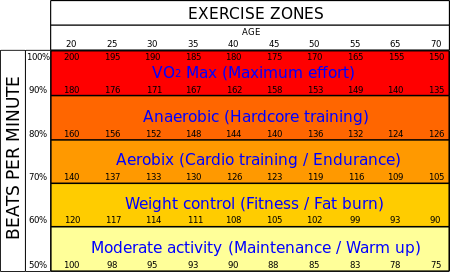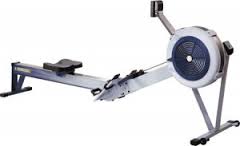Safely maximizing heart rate variability cleans and strengthens arteries as well as improving cardiac function. Exercising at maximum heart rate is controversial in some circles, so you should get an OK from from your doctor first.
is controversial in some circles, so you should get an OK from from your doctor first.
Intense interval exercise is known to be far more beneficial than what is referred to as ‘aerobic exercise’, even though it takes a lot less time. (All exercise is ultimately aerobic, which is why there are single quotes around that phrase. Dr. Ken Cooper coined the term; he was a wonderful man and told me some great stories but this word, ‘aerobics,’ is very misleading.The word is used to name sustained, sub-maximal exercise.) The reason intense interval exercise is so beneficial is simple. It causes your heart to vary, to vary as much as it can, usually. Rapidly up, rapidly down. This has a strikingly positive and rapid effect on atherosclerosis prevention and reversal, along with rapid improvement of a variety of blood markers.
The is the 5th in the exercise series. Joint maintenance was discussed here, balance and neurogenesis, here, and osteoporosis prevention here.
Most health sites, such as the American Heart Association, and many doctors, recommend mild aerobic exercise in varying forms and degrees. While better than nothing at all, it would be hard to characterize this form of exercise as particularly good. Typical advice looks like this: brisk walking 2½ hours per week, or jogging 1¼ hours per week are common. There are also frequent recommendations to keep your heart rate below a certain level. The level is a relatively low one. Here are some typical numbers:
| Age | Heart Rate Beats per Minute |
| 55 | 140 |
| 60 | 136 |
| 65 | 132 |
| 70 | 127 |
| 75 | 123 |
Ostensibly this is done in the interest of safety, but it has exactly the opposite effect. To preserve heart health and prevent atherosclerosis, it is necessary to run the heart up and down through all its possible pulse rates, including its maximum. The maximum heart rate for a 65 year old that exercises vigorously would probably be closer to 175 beats per minute than the 132 given in the chart.
These low heart rates correspond to the “standard medical practice” that seems to have a strange life of its own. There is absolutely no science, good, bad, or otherwise, supporting these low heart rates, nor has there ever been. It is some sort of superstition. We cannot figure out where it actually came from. On the other hand, there is a large body of science supporting the concept that varying the heart over its full range has huge health benefits and dramatically reduces heart risk.
Aerobic exercise is better than no exercise at all, but not by much. Keeping your heart rate moderately elevated for extended periods of time trains your heart and lungs to, well, stay moderately elevated, and, as you might suspect, this is only moderately beneficial.
However, moderate elevation of heart rate, even if prolonged, won’t begin to accomplish the physical and cellular changes necessary to avoid degenerative disease and slow aging. More intensity is needed. The heart needs far greater variability, including brief periods of maximal output. The arteries and veins need the temporarily elevated pressure and rush of blood that accompanies it. Only by punching through the barriers that aerobic exercises impose, can greater heart health be obtained.
How Safe Is This?
We are proposing running the heart to its maximum rate for short bursts. For which group of people might this be dangerous? Short answer: If you have no significant cardiac risk, it is completely safe. For most with cardiac risk it is safe. Further, such exercise vastly reduces overall cardiac risk for everybody. But with no trouble at all, you can find recommendations to limit your heart rate. For a 70 year old, the usual limit is 127 beats per minute. This is very low, and the results from exercising with this restriction will correspond.
The American Heart Association, has one-size-fits-all recommendations such as these on their website, but they also have a lot of good medical research there as well. In one paper, they investigated the safety of “maximal” exercise. Maximal exercise comes in many flavors, but will usually imply maximal heart rate, or at least a heart rate well above the lame standard limit. Out of 72,000 reported maximal tests, there was one reported cardiac death. In the last 10 years, none at all. This is safer that crossing the street, and safer than most other daily activities, and of course, the reduction of cardiac risk resulting from such exercise will save many, many people, likely tens of thousands, from cardiac death.
There are three categories of people that should avoid maximal exercise:
- If you have valvular disease, some defect in the valves of your heart, more than usual care should be observed. In such a case, be guided by your last echocardiogram and your cardiologist’s advice. He may be too restrictive but no other more general advice can be offered here.
- If you have mechanically unstable coronary artery disease sometimes the shear forces that are otherwise good for the heart might “shake loose” some of the detritus and trigger a clot and subsequent occlusion/blockage leading to a heart attack. This sounds so vague as to warrant the usual generic and tepid advice to severely limit your heart rate during exercise. Please do not hear this point in that way; superstition is not necessary. If you have any family or personal history of heart attacks you should nail down this risk by coronary calcium scoring and other additional measures to assess any such risk. If you and your cardiologist think this is a real risk, still don’t keep your heart rate as low as the table demands, but do proceed with more than usual caution.
- If you have a known serious heart conduction defect that has been clearly shown to be triggered by higher heart rates and is potentially life threatening then certainly observe the heart rate limits your cardiologist suggests. This electrical problem should be respected, though even here we are more likely to recommend this be repaired than drugged. After all, you need to take care of the rest of your health and do not want to be limited in this worthy endeavor due to heart rate limitations. If possible.
How to Run Your Heart Up and Down
We suggest here that you replace long easy sessions of aerobic exercise with short anaerobic sessions of intense exercise. You can start slowly if you like. In spite of the shorter time taken in interval exercise, the benefit is much greater. The heart learns to work over a variety of ranges, the arteries get needed pressure and pulsing. HDL2b, the “really good” cholesterol, will correspondingly rise. Risk for heart disease will plummet, as will cancer risk. If you are attempting to recover from adult onset diabetes, the rate of recovery will double. Heart rate variability is a major key to good, long-lasting, vibrant health, and the only way to get there is, as you might suspect, by varying your heart rate. The more variation, the healthier.
You should get a watch that will measure your heart rate, so you can track your progress. If a doctor has advised you to limit your heart rate to a certain level, you will definitely need to have one.
To run your heart up to its maximum, you need exercises that engage your legs and probably your back as well. An exercise using mainly arms, like swimming, probably won’t work.
Here are several possible methods. They would all be considered anaerobic, meaning your heart cannot keep up with the oxygen demand you are making. This is strongly desirable as it triggers processes in your body that will increase your ability to consume oxygen. Increases in oxygen processing correspond directly to increases in cellular and overall health. We will ultimately be recommending three exercise sessions a week, two demanding 45-minute ones, and a light one incorporating the balance, agility, coordination, and the joint health exercises discussed earlier.
Most gyms have a couple of these. If not, they cost about $800 new, delivered, which is cheap for an exercise machine, so you could suggest that your gym splurge for a couple. They aren’t out of reach for home use either. The rower requires the use of legs and back, and can get the heart to a maximum rate in under a minute. These machines are quite safe, the sole caveat being to row with a stiff, erect back, and avoid hunching over. Don’t start out trying to shatter any world records. Set up the machine for a 2,000 meter row, called the “2K.” Try to maintain a somewhat challenging pace. By around 1,000 meters, you should be well “challenged,” huffing and puffing, and finding it increasingly difficult to keep the initial pace. Complete the exercise as best you can.
Did you get a heart rate monitoring watch? Record your maximum rate, and how much it recovered in the 60 seconds after you finished. These are two key numbers you will want to track. A third key heart number is your resting heart rate. Measure this one lying in bed in the morning and before consuming any coffee. There is a fourth number of interest as well, which is the time it took you to do that 2K row. With this number, you can get an estimate of your oxygen using capacity, called VO2Max, from either the Concept2 web-site or directly from some of their rower models. More VO2Max, more life, more health, less aging. It’s the strongest predictive number we have, and the way to get that number up is anaerobic exercise.
After you have “mastered” the 2K row, you can try some intervals. Warm up for two minutes, then set the rowing machine up for time intervals, 20 seconds of rowing, 10 seconds of rest. Just punch the buttons till you find it or consult a local expert. Have the machine display watts. Give the first 20-second row all you’ve got. Anything left over can be done on the second row. If you have much left for the last three, you weren’t trying hard enough. Remember, the whole idea is to place demands on the heart and body that it cannot immediately fulfill so that it will undertake all the changes needed to increase your biological power.
If you are addicted to brisk walking, you might like this one. Briskly walk over to the nearest hill and run up it as fast as you can. If the hill is steep enough, you will start to run out of steam after 20 or 30 seconds. Set a ”finish” line about 10 yards beyond your out-of-steam point and chug on. Walk down and do it two more times. These additional times will be harder as your body hasn’t the time to replenish the energy store. This is desirable. You want your body to create more on-demand power capability.
If you weren’t out of steam after 30 seconds, briskly walk to a steeper hill. If you really aren’t enamored with brisk walking, you can just drive to that hill, but before the run, jog for a couple of minutes just to get the juices flowing (literally, if we are talking about joints), and get loosened up. Three 30-second hill runs don’t seem like a lot (though they will, 25 seconds into them) but the benefit far exceeds brisk walking or jogging. Again, if you have an upper limit on heart rate, observe it, and be sure that all the joints you will be using are in top shape from the earlier exercises. (Neat little ‘secret:’ hill work, while metabolically the most demanding of all, is actually fairly gentle on the joints as the absolute metabolic demand prevents you from generating excessive shear forces across the knees and back. I (Dr. Mike) can readily generate over 1,000 watts on hill work and live to tell about while if I try that on the flats at the track I am all but crippled for two weeks: old injuries.)
Wind Sprints
If you are in Kansas, or some other ultra-flat terrain, do this: Jog for about 2 minutes, then run at top speed for 30 seconds, then jog for a minute, sprint 30 seconds, and then once or twice more. Again, pay attention to maximum heart rate and joints. You old time runners know these as a variant of fartleks.
Other Methods
You can devise your own. Got a bicycle and some open space? Pedal like crazy for 30 seconds, then coast for a minute. A treadmill could work, set it for maximum steepness. Steepness is also important for avoiding injuries. The bio-mechanics of the treadmill are are very different from actual walking/jogging.
Biological Power
Remember, these exercises don’t have a set goal. The whole point is to keep pushing your body to do more and more, to continually increase your biological power. And this newly gained power will only partly be spent on your anaerobic sprinting skills. Other things will happen. New, strong bone will grow. High levels of HDL, the artery cleaner, will be generated. Cartilage growth will be stimulated. Cells will be kept clean all over your body.
We are almost there. The next post will describe how to increase your biological power by doing certain exercises somewhat differently than they are already done.


Dr. Mike,
Do you find R-R interval metrics useful to track? I know that not everyone would have access to heart sensing that has this capability, but if they did, is it any more useful than tracking what you have mentioned in this post?
Yes, Jim, it is very much more useful. Especially, but not only, to detect true heart rhythm problems. I give a simple example of this in the blog ‘A coffee story’ on whenyouareserious.com.
There is another interesting example of how we extinguished, through training, a very serious heart rhythm problem we found and subsequently treated with R-R data shown on the Facebook page “When You Are Serious.” For more mundane issues this value is of training interest in the recovery and post recovery heart rate analysis. The old saying “God is in the details” really applies here. Dr. Mike
Thanks – also meant to ask – how are you calculating watts when running hills?
Thanks – I re-read the When You Are Serious posts. Enlightening as usual. I noticed the comment regarding coffee and insulin resistance. Can you elaborate on that “pairing”? How does coffee affect or interact when considering insulin resistance?
Jim, you need to see how your heart rate responds to coffee and any effect it might have on sleep; those are two places to start. The genetics of caffeine clearance is at issue here but not only that. The short version is if coffee affects other metabolic markers as a prolonged stimulant then the insulin/glucagon relationship is imbalanced. As a general rule I don’t worry about coffee – Yum! – but it can be an issue in fat weight gain, sleeplessness, insulin resistance and other disorders in some people. Dr. Mike
How will I know if I’m “anaerobic” for the “anaerobic 2K row”? By heart rate?
Well, Kath, I hope you see the humor in this but we used to call this ‘the fall off and puke protocol.’ Grim, I know, but the underlying point was it has to be all out; I mean all out. Be trained and fit to do this; careful warm up too. Go! Dr. Mike